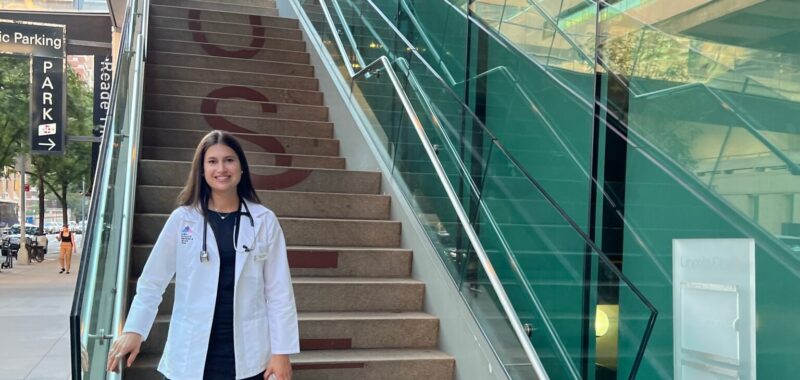The last time I walked into the School of American Ballet, I wasn’t carrying a dance bag. I was wearing a white coat.
Earlier that day, my medical school held its White Coat Ceremony at Lincoln Center’s Alice Tully Hall—on the same block where I had trained for over a decade. After the ceremony, I stopped by the studios I hadn’t seen since graduating from SAB. The light was the same. The floors still creaked in familiar places. But I had changed.
There were hugs from friends and former teachers, joyful disbelief that I was now in medical school. We talked about how more dancers are exploring academic careers alongside professional dance. And for the first time in a long time, I didn’t feel disappointment about not pursuing ballet professionally for longer. Instead, I felt proud. I was learning to embrace a new identity as a future physician—one that didn’t erase my past as a dancer, but expanded it.
I started ballet when I was 2, in a Mommy and Me class. At age 8, I auditioned for the School of American Ballet. From that year on, dance became my world. I missed birthday parties, vacations, and playdates without hesitation. I was the kid who’d say, “Sorry, I can’t—I have ballet.” And I was proud of it.

Performing with New York City Ballet as a child in ballets like The Nutcracker, A Midsummer Night’s Dream, and Swan Lake, I learned how to stay focused under pressure, how to take corrections, how to commit fully to every detail. At 16, I suffered an injury that forced me to take a step back. Around the same time, I began to explore other interests—I’d always loved helping people, and, when I was younger, I even dreamed of becoming a veterinarian. It felt like the right time to think about college.
I decided to apply early decision to Columbia University, drawn in part by its vibrant dance scene. When I told my high school guidance counselor that it was the only school I was applying to, she raised an eyebrow and said, “You need a longer list!” I shrugged and said, “If it doesn’t work out, I’ll just apply to more schools over winter break.” (Like it would’ve been that easy…) But that’s what dancers do—we figure out what we want, and we find a way to make it happen. Somehow, it worked out. I was accepted, and then deferred for two years to dance professionally with Connecticut Ballet and freelance in New York City.
Once at Columbia, I danced with every group I could—Columbia Ballet Collaborative, Columbia Repertory Ballet, the Columbia University Ballet Ensemble (where I served as artistic director), and the Columbia/Barnard Dance Department. Surrounded by peers who also balanced academics with a love for dance, I began to see a new path. I wasn’t giving up ballet; I was simply reshaping how it fit into my life.
During my first year of college, I had no idea what I wanted to study. I signed up for a psychology class because the brain intrigued me—especially in the context of the mental demands of dance. I loved it. I took more science classes. Then I discovered FlexMed, the Icahn School of Medicine at Mount Sinai’s early assurance program for college sophomores. It felt like the perfect fit. I applied, was accepted, and a new dream began to take shape.
Since starting medical school, I’ve found countless ways to stay connected to dance. For instance, I co-founded a ballet program for children with autism, created a Dance and Medicine elective for my classmates focused on the therapeutic benefits of movement, and began pursuing research that bridges my medical interests with my ballet background. I’ve learned that the discipline, adaptability, and creativity I developed in the studio show up every day—in patient care, in problem solving, and especially in the operating room.

When I scrubbed in for my first surgery, it felt strangely familiar—there was music playing, overhead lights shining, and a team working in synchrony, each person with a precise role. The energy reminded me of a performance. Even the process of preparing—scrubbing, gowning, gloving—felt like sewing a pair of pointe shoes or putting on a costume. There was something deeply familiar about it. I felt strangely at home.
I now want to become an orthopedic surgeon—something that, in hindsight, feels like a natural evolution of my ballet training. Years in the studio taught me to understand the body in motion, to notice subtle misalignments, and to recover from injury with intention. I’d spent countless hours working with my own musculoskeletal system—refining it, testing its limits, and learning how it functions under pressure. One of my teachers, Kay Mazzo, once told us, “You can do the same tendu every day and go nowhere—or you can do it with intention and improve.” That mindset—focused, deliberate effort—now guides how I study anatomy, practice suturing, and approach medical research. Ballet didn’t just give me discipline. It gave me a lens through which to understand the human body, and a sense of purpose I can now carry far beyond the studio.
I know firsthand how difficult it can be to step away from the stage and ask, “What now?” For a while, I felt like I was losing a part of myself. But over time, I realized I wasn’t leaving dance behind. Today, I stay connected to it in ways I never expected—as a teacher, through research exploring the therapeutic benefits of movement, and through mentorship. My younger self probably wouldn’t have imagined I’d one day stand in a white coat at Lincoln Center. But what I’ve learned since then is that dance doesn’t just prepare you for the stage—it prepares you for life.

